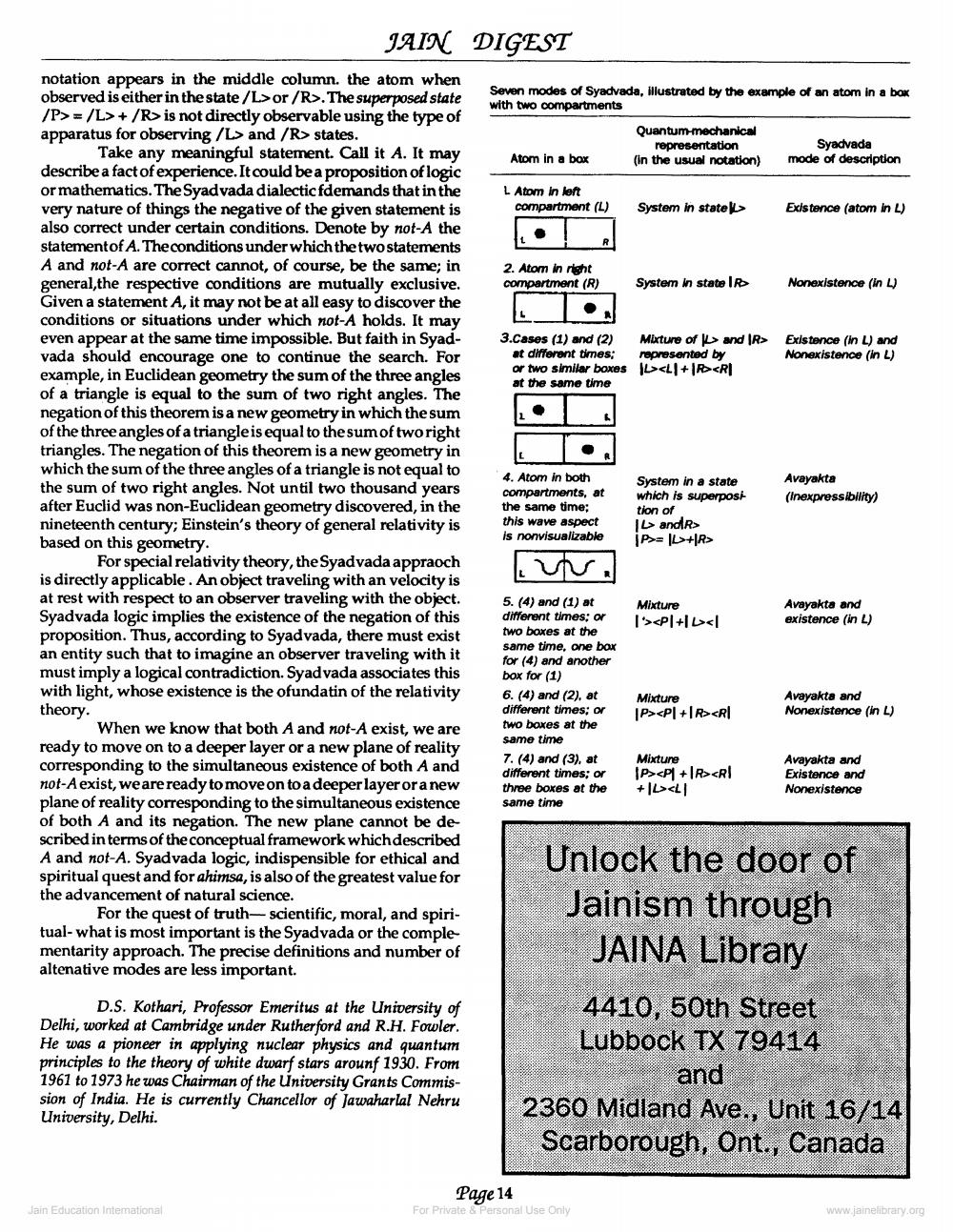________________
JAIN DIGEST
Seven modes of Syadvada, illustrated by the example of an atom in a box with two compartments
Quantum mechanical
representation (in the usual notation)
Atom in a box
Syadvada mode of description
L Atom In left
compartment (L)
System in statek
Existence (atom in L)
2. Atom in right compartment (R)
System in state IR
Nonexistence (in D)
3.Cases (1) and (2) at different times; or two similar boxes at the same time
Mixture of and IR> represented by
<L+ <RI
Existence (In L) and Nonexistence in L)
Avayakta (Inexpressibility)
notation appears in the middle column. the atom when observed is either in the state/L>or/R>. The superposed state /P>= /L> /R> is not directly observable using the type of apparatus for observing /L> and /R> states.
Take any meaningful statement. Call it A. It may describe a fact of experience. It could be a proposition of logic or mathematics. The Syadvada dialectic fdemands that in the very nature of things the negative of the given statement is also correct under certain conditions. Denote by not-A the statementof A. The conditions under which the two statements A and not-A are correct cannot, of course, be the same; in general, the respective conditions are mutually exclusive. Given a statement A, it may not be at all easy to discover the conditions or situations under which not-A holds. It may even appear at the same time impossible. But faith in Syadvada should encourage one to continue the search. For example, in Euclidean geometry the sum of the three angles of a triangle is equal to the sum of two right angles. The negation of this theorem is a new geometry in which the sum of the three angles of a triangleis equal to the sum of two right triangles. The negation of this theorem is a new geometry in which the sum of the three angles of a triangle is not equal to the sum of two right angles. Not until two thousand years after Euclid was non-Euclidean geometry discovered, in the nineteenth century; Einstein's theory of general relativity is based on this geometry.
For special relativity theory, the Syadvada appraoch is directly applicable. An object traveling with an velocity is at rest with respect to an observer traveling with the object. Syadvada logic implies the existence of the negation of this proposition. Thus, according to Syadvada, there must exist an entity such that to imagine an observer traveling with it must imply a logical contradiction. Syadvada associates this with light, whose existence is the ofundatin of the relativity theory.
When we know that both A and not-A exist, we are ready to move on to a deeper layer or a new plane of reality corresponding to the simultaneous existence of both A and not-A exist, we are ready to move on to a deeper layer ora new plane of reality corresponding to the simultaneous existence of both A and its negation. The new plane cannot be de scribed in terms of the conceptual framework which described A and not-A. Syadvada logic, indispensible for ethical and spiritual quest and for ahimsa, is also of the greatest value for the advancement of natural science.
For the quest of truth-scientific, moral, and spiritual- what is most important is the Syadvada or the comple mentarity approach. The precise definitions and number of altenative modes are less important.
4. Atom in both compartments, at the same time: this wave aspect is nonvisualizable
System in a state which is superposi tion of 1 and R> iP>= |L>+IR>
Mixture 1><P
Avayakta and existence in L)
5. (4) and (1) at different times; or two boxes at the same time, one box for (4) and another box for (1) 6. (4) and (2), at different times; or two boxes at the same time 7. (4) and (3). at different times; or three boxes at the same time
Mixture P><Pl+R
Avayakta and Nonexistence in L)
RI
Mixture P><P+R><RI
L<LI
Avayakta and Existence and Nonexistence
D.S. Kothari, Professor Emeritus at the University of Delhi, worked at Cambridge under Rutherford and R.H. Fowler. He was a pioneer in applying nuclear physics and quantum principles to the theory of white dwarf stars arounf 1930. From 1961 to 1973 he was Chairman of the University Grants Commission of India. He is currently Chancellor of Jawaharlal Nehru University, Delhi.
Unlock the door of Jainism through
JAINA Library 4410, 50th Street Lubbock TX 79414
and 2360 Midland Ave., Unit 16/14 Scarborough, Ont., Canada
Page 14 For Private & Personal Use Only
Jain Education Intemational
www.jainelibrary.org




